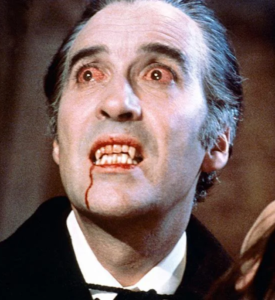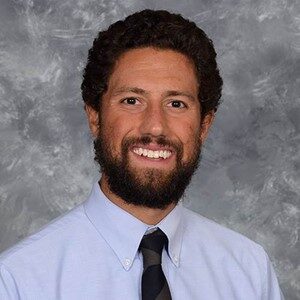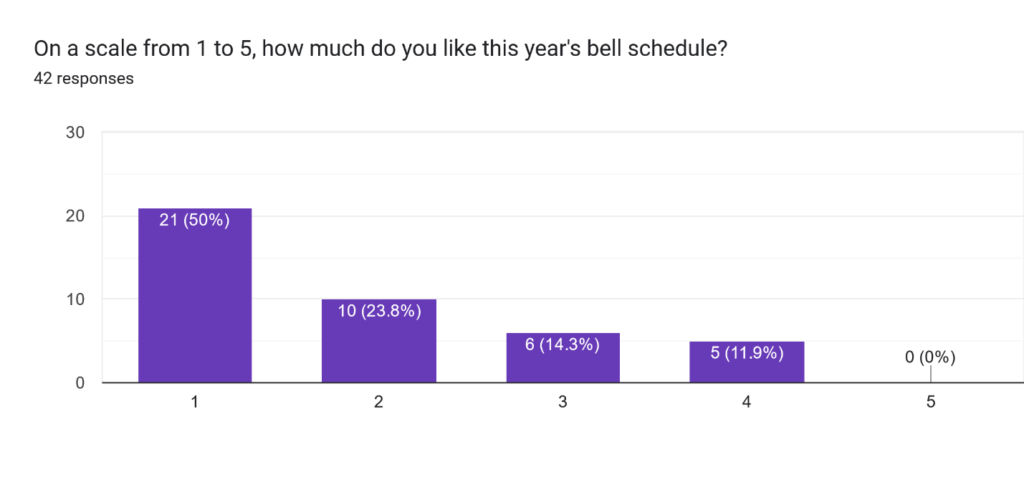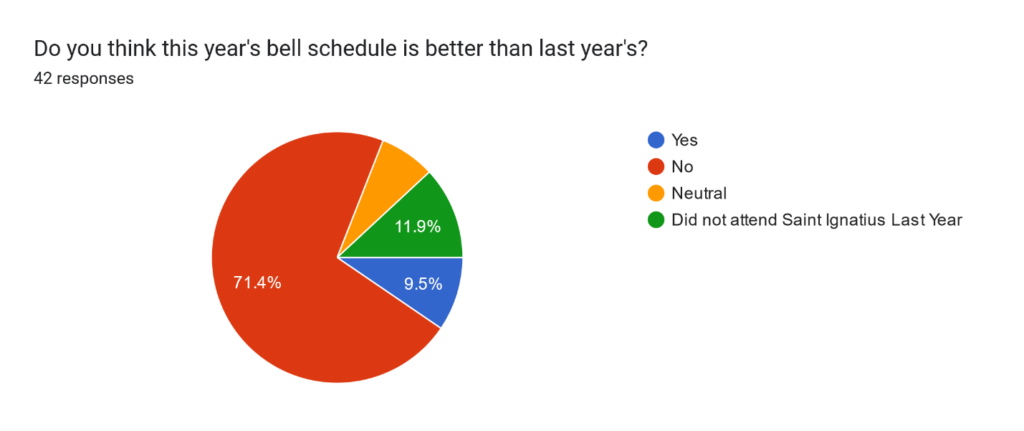Our favorite Ignatius teachers who might trick-or-treat without a costume this year.


——————————————————————————————————


——————————————————————————————————


——————————————————————————————————


——————————————————————————————————


Our favorite Ignatius teachers who might trick-or-treat without a costume this year.


——————————————————————————————————


——————————————————————————————————


——————————————————————————————————


——————————————————————————————————


By Kelly Coleman ’23
I sat down with our Assistant Principal for Academics, Mr. David Sabol ’99, in an exclusive interview to discuss this year’s changes to the schedule. Here’s what happened.
Before we talked about this year’s schedule, Mr. Sabol and I discussed why the school changed from the 9-period schedule at all. He explained that the shift to the schedule we have now had been planned for a long time. From the beginning, it was envisioned that a new schedule would have longer classes that met less often, time during the day for activities, built in professional development time for teachers, and the addition of an advisory period. The administration had been waiting for an opportunity to implement changes to the schedule, and the return from distance learning post-Covid provided the perfect time to make the change.
Moving on, we began talking about this year’s schedule specifically. Of course, the conversation quickly turned to the lunch period. Under last year’s system, lunch, extracurriculars, and advisory were all competing for students’ time in the same block in the middle of the day. The decision was made to remove lunch from that block and implement a split lunch system — a system used by many other schools. As Mr. Sabol explained, the driving goals of the changes were to reduce the stress on the dining staff and to shrink lines. Last year, the dining staff had to prepare enough food in the morning to feed the entire student body at once as everyone poured into Rade to eat right at the start of the period. Now, the lunch periods are staggered by the location of a student’s third period class. This allows the dining staff time between lunch periods to prepare and restock, correcting a significant problem from last year’s schedule.
Mr. Sabol acknowledged students’ complaints about not being able to eat lunch with friends but noted that, before last year, that had never been the norm. He pointed out, “Under the 9-period schedule, there were people that you would never have the same lunch period with throughout the entire year,” while under the new schedule, students will share a lunch with many different people as the schedule cycles through on a predictable basis. Regarding complaints about lunch line lengths, he stated that the school had measured an overall reduction in line sizes compared to last year and had received positive feedback from the dining staff on the changes’ effects.
Another goal of the changes to the schedule was to rekindle the after school environment by encouraging extracurriculars to utilize that time to meet instead of just relying on the activities period. As Mr. Sabol explained, “In past years, there was a greater after school culture. People would stick around after the school-day ended for clubs and other activities. But Covid changed that. Students starting going home right after classes were finished, and the school began to empty out after 3 o’clock.” He asserted that the administration “want[s] to encourage students to stay on campus during that time after school.” One reason that the end of the school day was shifted from 3:15 to 3:05 was to give students that extra time after school to meet and organize groups, and Mr. Sabol urged students utilize that time for extracurriculars.
Moving forward, Mr. Sabol noted that the administration continues to evaluate feedback from students, faculty, and other focus groups in order to guide future changes. Mr. Sabol encourages students to continue giving feedback to the administration; however, he also expressed that changes are difficult to implement mid-year. He finished our interview by acknowledging that the schedule is never going to be perfect because “ultimately, every schedule is going to have tradeoffs” but emphasized that the administration is listening and is dedicated to developing a schedule that works best for everyone at Saint Ignatius.
by Kelley Coleman ’23
Beloved readers, the time has finally come: we know that you have been waiting with bated breath to hear the results of our most recent poll on the new schedule. Well, wait no longer, for we have come to bequeath the results unto thee.
The survey itself was simple: two optional questions (both multiple choice), and one free response section for students to share their thoughts. We received over forty anonymous responses in total and have found their words to contain much insight. Without further ado, here are the results.

Our survey was basic and is biased in that people who are unhappy with something are much more likely to respond to an optional survey about it then people who are more or less okay with it, but I believe that the results do reflect that the new schedule is generally unpopular with the student body. We have selected some of the most notable responses from our survey to be highlighted here.
The overwhelming majority of the free responses expressed discontent with the new schedule, specifically on the changes to the lunch period. As one student elegantly put it: “I HATE THE NEW BELL SCHEDULE … I DON’T SEE HALF OF MY FRIENDS LIKE I DID LAST YEAR.”
Aside from lunch, the subject that was brought up most frequently in the responses was the change to the activities period and advisory. One student stated:
“I feel that the problem with last year’s schedule was that advisory interfered with club times. That was the one fix I really felt was needed but this year that just made it worse, essentially locking Tuesday and Thursday formation periods from having any clubs at all.”
One student expressed his frustration with the new schedule from an extracurricular organizer’s perspective:
“It doesn’t solve the lunch problem that it was supposed to solve, it instead made it worse and the line is long throughout the entire period. I also don’t like how I can’t have lunch with my friends every day of the week. I run [a] club, and it’s hard to schedule a meeting that everyone can attend because of the advisory schedule and lunch being different for everyone.”
Most interestingly, we received a response from someone identifying themselves as from Campus Dining:
“I am on the Campus Dining staff and I like the change in the schedule this year. It allows time in between the two lunch periods to replenish with fresh food before the next group comes. Last year we had to cook all the food at 9:00 a.m. for the large group (which was basically the entire student body) at once. We have taken notice of the amount of time it takes students to wait in line at the start of the lunch period and it takes 15-20 max until the line dies down. My suggestion to students would be to wait 15 minutes if they want to get through the line quickly. They will then still have plenty of time to spare to eat their lunch before they have to get to class. We love serving the students and staff in Campus Dining. Thank you for being patient with us while we are always trying to improve more efficient ways.”
The Eye would once again like to thank everyone who took the time to share their thoughts and opinions with us. But we haven’t been the only ones talking about the schedule. We sat down with Assistant Principal Mr. David Sabol ’99 for an exclusive interview about the changes to the schedule, in which he responds to many of the most popular comments students made about it. Please read this article to hear the administration’s thoughts and understand why changes were made!
by Aidan Oliss ’23
Last weekend, we saw the golf team wrap up the playoffs with an outstanding performance culminating in a team score of 610 which captured a fourth state title for the Saint Ignatius Golf Team. We also had Nick Piesen ‘23 secure the individual state title with a personal tournament score of 148 (74-74) and everyone on the team finishing in the top 25: Bradley Chill ‘24 tied for second place, Connor Malicky ‘23 and Julian Dugan ‘24 tied for 21st place, and Michael O’Leary ‘23 tied for 24th. After this remarkable team performance, I spoke with Nick to get his thoughts and feelings on the championship tournament and what this victory means for the golf team.
Nick began by saying, “Winning a team state championship is really special, especially back-to-back. This week was special and was a great ending to my high school career.” Nick further explained how hard they worked during the season: “We worked so hard the whole season to get to this point and that hard work paid off.” Nick also provided his opinion on the key moments in his championship match: “There definitely were some key moments, on holes 12 and 13 on the final round I made a 20 footer and 30 footer which gave me momentum finishing the final round.” Nick then detailed his mental state going into the game and his feeling after the 18th hole: “That day I felt so confident in what I was doing, I was in complete control of my game. The feeling of walking up the 18th hole was awesome, a memory I’ll never forget.”
Lastly, Nick proudly stated, “This team will forever go down in history!” Thanks to the top tier performance by the entire team, that vision has now become a reality. It has become undeniable that our golf team was special this year and deserving of a record setting back-to-back state championship, making Saint Ignatius High School golf history with their performance. Nick has committed to Indiana University for golf, and we look forward to watching his continued success there.
by Hans Engel ’23 and Christian Durny ’23
Our decision to go to Heart of Gold was not one of immense planning. We looked at Google reviews as one does and came across this little-known place right on Loraine. Inspired by a good looking picture of a burger, we settled on it and traveled all of .3 miles to our next review. From the outside, Heart of Gold gives off the typical aura of the Ohio City establishment. We were worried at first that we picked a more drink-oriented establishment, but we were met with good service and an appetizing menu.
Heart of Gold is relatively expensive. Its menu is short but provides viable options to even the most picky of eaters. Feeling like some comfort food, we ordered their chicken sandwich and some burgers. For some reason, my chicken sandwich was on special, so I was able to snag it for $9 while each burger was $15.
We at the Saint Ignatius Food Review feel very adamant about sides. We believe every good meal requires something else, typically fries with any sort of sandwich — a view the vast majority of Ignatius students would support. This philosophy is why we were extremely disappointed that our food didn’t come with any sides, providing our biggest complaint about the restaurant.
Here comes the good news. Our absolute favorite aspect of Heart of Gold was the taste. Almost nothing compares to the great feeling of a juicy, warm burger on a chilly fall day, but the cornerstone of my experience was that chicken sandwich. The first thing I thought of when they brought it out was they just fried an entire chicken and put it between two buns. I really appreciated the size. They could have easily cut the breast in half and made two full sandwiches, but they went the extra mile. It looked like one of those Tik-Tok creations, but it definitely wasn’t “Stunt Food”. Extremely juicy and tender, the sandwich was a perfect blend of sweet, salty, and fatty goodness. Overall, I appreciated my stay at Heart of Gold. Although it comes with imperfections, — seriously, just give me fries — I think the Ignatius student could forgo Hex or OCB and enjoy Heart of Gold in a new restaurant rotation. We give Heart of Gold a 7/10.
by The Eye Staff
… they don’t make camouflage golf balls? Or do they?
… we allow golfers to club baby balls?
… Mr. Crew coaches soccer?
… cross-country runners are so much faster in Luxembourg?
… you can be penalized for kicking a football?
… I couldn’t get a Wildcat Nation t-shirt in extra medium?
… we brought back How Comes?
by Jackson Kenny ’26
When cast member Jackson Gordon ‘24 initially learned that the Saint Ignatius Harlequins had selected The Laramie Project as their fall play, he was shocked because “It’s such [a] heavy subject matter that, in the past, would have even been controversial to speak about.”
The Saint Ignatius Harlequins are currently preparing performances of the fall play, The Laramie Project. The play was originally written by a group known as the Tectonic Theater Project constructed from interviews with the people of Laramie, Wyoming after the beating and torture of Matthew Shepard, a gay man, in October of 1998, which subsequently led to his death. The Eye was able to ask questions to members of the student cast and crew about their experience with the show and what they hope it accomplishes in the Saint Ignatius community.
Every member of the cast plays a myriad of characters on different sides of the issues facing the town of Laramie, and student director and Beaumont High School senior Emma Schoeffler loves the amount of different perspectives this allows: “I love how many different perspectives into the event there are and how there are never really any judgments made on these perspectives – it really shows that the people who made this show spent a lot of time in the community and really got to know the people there.”
The show is clearly an emotional piece, both because of the intense subject matter and because it is a true story. That means that all of the characters in the show are real people. Cast members Jackson Gordon ‘24 and Tony Fitzgerald ‘26 made salient points about having to play difficult roles. Jackson Gordon ‘24 says, “It’s a lot. It’s really hard because all of it is real; these were real people and you have to get yourself in a place to say some awful things. Just the idea of it can feel dirty. The words aren’t pretty. Tackling that and not feeling like dirt afterwards is not an easy thing.”
Tony Fitzgerald ‘26 says, “It’s really difficult trying to relate to some of [my] characters because [some characters can be] very hateful and very spiteful; knowing that the characters in this show are real people, knowing that they really exist makes it even more difficult.
Cast member Tommy Bilczo ‘24 also noted an important point about the way the show treats the concept of human dignity, an essential phrase for the Harlequins as they navigate this difficult process: “I find it really interesting that people in the cast have to portray murderers with the idea that even those murderers have human dignity that they can’t take away.”
Cast member and Magnificat High School senior Kristina Telban said that although grasping the concept that this was ‘a real event that actually happened’ was initially difficult, doing research about her characters helped her realize that these characters had a life outside of the words written on the page, which has immensely helped her character work throughout this process.
On the technical side of things, lighting designer and Saint Joseph Academy senior El Healey says that the hardest challenge has been the collaboration between departments and the heavier tone of the show: “[The hardest part has been] the collaboration between departments. I’m the lighting designer, but I’ve had to work closely with stage management, scenic design, and sound design at different points so we can put forth a product that really works cohesively.” El also said that working on a show with potential impact beyond the stage has put pressure on the Harlequins to deliver the best show possible, but they have confidence that the cast and crew are on track to make the show the best it can possibly be.
The Harlequins hope that the experience students have watching the show will have an impact on day-to-day life at Saint Ignatius, specifically concerning the treatment of LGBTQ+ students. As Kristina notes, “LGBT people today are still facing discrimination and violence constantly, and this is a frequent thing that still happens so it’s very important to raise awareness about it, and I think that human dignity is really important in today’s society.”
El Healey says, “I mainly hope that they understand that this is a story about a community learning about itself and, in turn, reflect that learning back onto themselves. Nobody in this story is perfect, but that doesn’t mean they don’t deserve dignity. That’s a word we’ve used a lot recently, dignity. It’s really the thesis of this show. Treat each other with dignity and respect; you won’t always be perfect but trying is what allows us all to grow.”
Saint Ignatius High School’s own Jackson Gordon says that the play is directly relevant to the school: “I know from experience I can just casually hear the ‘f-slur’ being said in the hallways, with no one batting an eye. And, of course, it’s not as bad as it once was, but if someone sees a play like this, and, you know, maybe they haven’t been the best in the past when it comes to [LGBTQ+ inclusion], if they can recognize their actions… I would love to see a bit more awareness, a bit more respect, a bit more acceptance. That is something Ignatius definitely needs going forward, not to mention the rest of the world.”
Ticketing information for The Laramie Project can be found at ignatius.edu/drama. The production runs November 11-13th.
by Shivam Pandya ’24
At some point during your time at St. Ignatius, you’ve probably heard of Model UN or the DiploCats. Model UN is one of the premier clubs on campus, with over 75 members and a track record of excellence and our members winning countless individual and team awards. The club is co-moderated by Mr. Brandon Foster and Mr. Peter Corrigan ‘69. Club members travel to college campuses, engross themselves in real-world debate, and hopefully come home with a Best Delegate gavel.
At competitions, students become delegates acting in the interests of either a county, corporation, or high-powered individual. Every committee, or group of delegates, has a central issue they’re trying to solve. Delegates give short speeches to establish a position on the topic to the rest of the committee before working with other delegates who share similar viewpoints — also known as a bloc — to write a full resolution to the issue; this effort includes explaining how to fund the solution, what the social implications are, what your country’s government thinks about the solution, and more. The delegate who is most active in committee and most invested in creating a good solution wins.
Model UN is arguably the most proficient club in the school for making members better public speakers, collaborators, and decision makers — essential skills. Being comfortable and confident speaking in front of upwards of 50 people is something that many people do not possess, and knowing how to communicate well in this type of setting makes a more attractive candidate to colleges and employers.
Model UN is always open to new members: just walk in to Mr. Foster’s room SC102 on either Mondays or Wednesdays during the Activities Period. The Club addresses the same material on both days, so join Model UN on the most convenient day.
We hope to see you there,
The Secretariat
by Young Kim ’23 & Seth Wojnar ’23
You may have seen the stand at the extracurricular fair or heard the name called over the announcements, but you may still not know much about the Saint Ignatius Entrepreneurship Academy, or SIEntA for short. Moderated by economics teacher Mr. Hess ‘88, SIEntA meets every Friday during formation period in Loyola Hall Room 328. Hear from experienced entrepreneurs including Mr. Hess himself and other special guests about topics in the world of business, ranging from the art of creating a business from the ground up to finance, the stock market and investing strategies, current events, and the study of economics.
No matter your interest, SIEntA has opportunities that will appeal to you. If you are an investor, you will be delighted to hear about our ongoing $100,000 virtual stock market competition in which you can test your investing skills and expertise for real cash prizes. If investing isn’t one of your interests, there are still many opportunities in other areas in the business world. For example, you might have more of an entrepreneurial spirit, and creating your own company and being your own boss sound more like the career path for you. If so, you might have a great idea for a new business or you might be already running a business of your own. To serve these interests, SIEntA offers an annual shark tank competition in May in which you can compete against other students to win real cash prizes!
These are just two of the many opportunities offered by SIEntA. Beyond these, there is fully transferable college credit available if you take an end of year test through the University of Iowa. You can travel to your grade school and teach about financial topics through Mr. Hess’s AlphaJump and serve as an entrepreneurial mentor.
Get a leg up on your peers by learning about these important real world financial topics and why it’s so crucial to learn and get started early. We are always open to new members, so feel free to drop in to one of our meetings on Friday in LH328.
We can’t wait to see you there.
by Jack Brennan ’24
The Soccer Cats are gearing up for the 2022 playoff run. The soccer program recently has found significant success in the OHSAA playoffs, winning the last three state championships by a combined score of 10-2. The team has carried on their dominance this season; however, it hasn’t come without adversity.
The Varsity Wildcats entered the season with a significantly more experienced group of seventeen seniors, six juniors, and six “swing” sophomores led by an outstanding group of captains: midfielder Nolan Spicer, the recipient of the 2021 Ohio Gatorade Player of the Year Award; goalkeeper Patrick McLaughlin, who came one clean sheet shy of tying a Saint Ignatius scoring record with eighteen; Nathan Trickett, whose immense offensive talent at the wing helped lead the 2021 team to their 140 goal season; and Owen Sullivan, a key defensive leader on the 2021 state championship team. Led by this core of star players, the team stood atop the state of Ohio as the season began.
After going undefeated in their three preseason games, the team would win their first two regular season games with relative ease, beating Avon Lake and Twinsburg by 5-0 and 9-1. They traveled to Toledo to compete in the Jesuit Cup. To this point, every St. Ignatius soccer team to win the state championship has also won the Jesuit Cup. Understanding this importance, the team won in convincing fashion, beating St. Xavier 6-2 in the semifinal and St. John’s Jesuit 8-0 in the final and hoisting the Jesuit Cup trophy for the fifth straight year. The team then defeated University School, St. Charles, Mason, Shaker Heights, Toledo St. Francis, and Massillon Jackson, establishing their dominance of the state.
Then began one of the most difficult weeks in the program’s history. For years, the soccer program has sought to play elite opponents across the nation. True to this aspiration, the team embarked on a trip to New York and New Jersey to play against second-ranked Saint Benedict Prep and Chaminade High School, a New York soccer powerhouse.
Lacking key winger Captain Nathan Trickett, the Wildcat offense stagnated against Saint Benedict, and the defense could only hold off the talented Benedict forwards for fifteen minutes. Still unable to enter an offensive groove, the team was unable to equalize after conceding a second goal late in the second half. The mighty sixty-eight game winning streak ended as the team fell to second in the national rankings. The team would be forced to push beyond their strong disappointment, however, as they still had a week of games ahead of them.
The next day, the Wildcats traveled to Long Island to take on Chaminade High School. Chaminade didn’t quite have the same accolades as St. Benedict, but they were a worthy opponent. Fueled by the thirst for revenge, the Wildcat side scored in the first ten minutes. They never looked back and came away with a satisfying 4-1 victory.
The tireless week was not over yet, though. The Wednesday following the trip, they returned to Wasmer Field, taking on Western Reserve Academy, ranked 25th nationally by the United Soccer Coaches Committee. They fell behind 1-0 early in the second half of the game, but two heroic goals by Nolan Spicer and a final seal by Owen Sullivan in the last ten minutes of the game carried the Wildcats to a scrappy comeback victory.
The coming Saturday, the team played their fourth game in seven days against Calvert Hall, a team from Maryland ranked top 10 nationally. The Cats began an early 2-0 lead, but exhausted from the long week and with four starters inactive due to injury, they couldn’t maintain the lead and fell 4-2 after one of the most difficult weeks in program history.
Despite a pair of defeats and losing their top spot nationally, there was a sense of accomplishment among the team: “Too many teams are happy with a good record at the end of their season having played nobody. That gets you nowhere,” said head coach Mike McLaughlin ‘85. “The more you can prepare yourself during the regular season, the more you’re going to be ready for the playoffs.” This attitude echoed throughout the program, and the players, rather than sulking about outcomes, used it as an opportunity to improve and prepare for the playoffs ahead.
The team bounced back and won their final two games, picking up a 4-0 victory over the St. Edward Eagles and a 1-0 victory over Dublin Jerome. They ended the regular season with a record of 14-2, with a total of sixty-seven goals for and fourteen goals against.
At the time this article is published, the team will already have begun their playoff run. Their first two will be played at Wasmer Field before finishing at Lower.com Field in Columbus, Ohio for the OHSAA State Championship. Over the past few years, the team has seen great student section showings, and the team is looking forward to this support continuing: “Soccer is such an emotional game, and to have that emotional charge from the fans, it makes a big difference. So fans, please, help us to win” said 11-time state and 7-time national champion coach Mike McLaughlin ‘85.
Information on the games and the brackets will be posted on the Ignatius Soccer Homepage for fans to support them during their hunt for the fourth straight state championship.